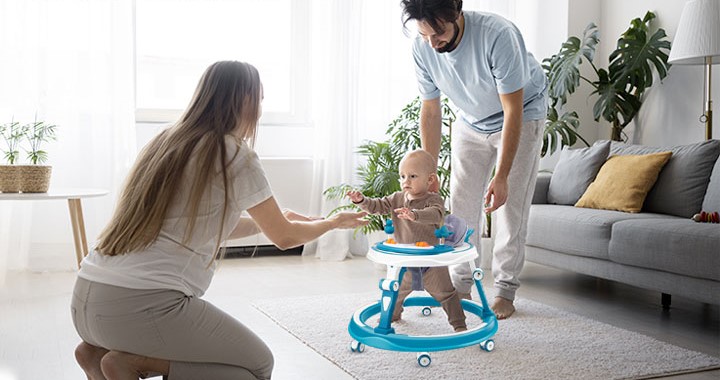
As parents, we are always on the lookout for tools and products that can aid in our child’s development. One such product that has been a topic of debate is the baby walker. While baby walkers offer several benefits, they also come with certain risks and drawbacks that parents should consider before making a purchase. In this blog, we’ll delve into the advantages and disadvantages of using a baby walker to help you make an informed decision.
Advantages of Using a Baby Walker
- Encourages Mobility
- A baby walker allows babies to explore their environment before they can walk unaided. The support provided by the walker gives them the freedom to move around, which can be exciting for curious little ones. This early mobility can foster a sense of independence and encourage physical exploration.
- Strengthens Leg Muscles
- Using a baby walker can help develop the leg muscles that are crucial for walking. As babies push the walker and move around, they exercise their legs, which can help build the strength needed for walking on their own.
- Stimulates Cognitive Development
- Many baby walkers come equipped with interactive toys, lights, and sounds that stimulate a child’s senses. These features can enhance cognitive development by encouraging problem-solving skills, improving hand-eye coordination, and fostering curiosity.
- Provides Entertainment
- Baby walkers can keep babies entertained for extended periods. With built-in toys and features, walkers can engage your child and keep them occupied, giving parents a little break while ensuring the baby is still active and learning.
- Boosts Confidence
- A baby walker provides a safe environment for babies to practice standing and taking their first steps. This can boost their confidence as they gradually learn to balance and walk independently.
Disadvantages of Using a Baby Walker
- Safety Concerns
- One of the most significant disadvantages of baby walkers is the potential safety risk. Walkers can allow babies to move quickly, increasing the risk of accidents, such as falls down stairs, bumping into furniture, or reaching dangerous objects. The American Academy of Pediatrics (AAP) has even recommended against their use due to these risks.
- Delayed Motor Skill Development
- Some studies suggest that prolonged use of a baby walker may delay the development of key motor skills, such as crawling and walking. This is because the walker supports the baby’s weight, which might prevent them from developing the necessary balance and muscle strength needed for independent walking.
- Encourages Toe-Walking
- Babies in walkers tend to push off with their toes, which can lead to a habit of toe-walking. This may affect their gait and walking patterns, leading to potential issues as they grow older.
- False Sense of Security
- Parents might feel a false sense of security when placing their child in a walker. While it may seem like the baby is safely contained, the increased mobility can expose them to hazards they wouldn’t encounter if they were just crawling or sitting.
- Restricted Natural Movement
- Walkers can restrict a baby’s natural movement patterns. For example, instead of learning to pull themselves up, crawl, and walk at their own pace, babies in walkers might skip some of these important developmental steps. This can impact their overall motor development.
Conclusion
While baby walkers offer several advantages, including encouraging mobility, strengthening leg muscles, and providing entertainment, they also come with notable disadvantages, particularly in terms of safety and potential delays in motor skill development.
As a parent, it’s essential to weigh these pros and cons carefully. If you choose to use a baby walker, it’s crucial to ensure that your home environment is safe and that your baby is supervised at all times while using the walker. Alternatively, you might consider other methods to encourage mobility and development that do not carry the same risks.
Ultimately, every child is different, and what works for one may not work for another. Making an informed decision based on your child’s needs and developmental stage is the best approach







